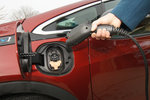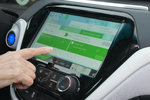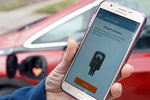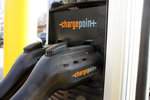







During the two years that Rod Johnson and his wife, Kathy Hollander, have owned their all-electric Chevy Bolt they have been able to cross routine auto maintenance off their “to do” list.
“We have had to change windshield wiper fluid one or twice, but that’s about it,” Johnson reports. “The car has really run maintenance free.”
Rather than filling a gas tank every few weeks, the Longfellow couple merely plug their Bolt into the standard 110 electrical outlet in their garage and let the car sit there overnight while it is being charged.
The Johnson Hollanders belong to a growing group of electric vehicle (EV) users that power their cars by connecting to an electric outlet or charging station. In Minnesota, that group numbers nearly 15,000. “We are seeing a substantial increase in the numbers of EVs on the road in this state and nationally,” says Diane McKeown, the metro area director for the Clean Energy Resource Teams. (CERTs). “That trend is going to continue now that more models with broader driving ranges are coming on the market.”
Johnson says that the family Bolt can run for up to about 240 miles on a full charge. “That is more than enough for our driving in town. We plug the car in the garage about once a week, Even then, we find that we don’t need a full charge. If we were planning a longer drive over several days, we would need to plan in advance and identify charging stations along the way. But charging has not been an issue for us.”
Johnson has not calculated the amount of electricity that the Bolt uses each month, but that amount is dollar terms is minimal, he says. “We really haven’t seen any significant increase in our monthly Xcel bill. Our electric clothes dryer costs more to run than our car.”
Early tech adopter
Like the Johnson-Hollanders, Nancie Hamlett drives a Bolt, but the Chevrolet plug-in was not her first all-electric car. An early technology adapter, Hamlett started driving a Zap-Xebra in 2006 when all-electric cars were a rarity. “I felt like a real energy pioneer when I was driving the Xebra,“ Hamlett said. “People would give me a thumbs up when I was on the road with it.”
But the three-wheel plug-in, with a range of 80 miles on a full charge, never caught on in the broader market. After only three years in production, the China-based ZAP Corporation stopped manufacturing the Xebra in 2009.
After the Xebra, Hamlett drove hybrids, but decided to go all-electric in 2019. “Hybrids meant that I had two systems, one electric and the other combustion, so I decided that an all-electric plug-in made more sense because the maintenance was a lot simpler,” she said.
Hamlett started with a Nisan Leaf in 2019 and moved on the Chevy Bolt in 2020. “I only need one charge a month,” she explained. “The Bolt has a range of 240 mile on a full charge, but I find that I can get up to 320 miles because I am only driving around town. At most I am spending about $5 a month for the electricity needed to run the car.”
Hamlett and Johnson-Hollanders purchased their Bolts while the federal tax credit for the General Motors vehicle was still in effect, but that tax credit expired in April 2020. Since then, GM has compensated for the loss of the credit by enhancing the company discounts for the Bolt.
“We haven’t seen any drop in sales now that the credit has disappeared,” reports Paul Zirbes, general sales manager for Roseville Chevrolet. “Early on, limited availability of charging stations had hampered EV use to some extent, but we don’t see that as an issue in the Twin Cities. “More than 80% of our Bolt customers are able to charge their cars in the privacy of their own homes and get the driving range they need on a day-to-day basis.”
When EVs first came on the market in the early 2000s, Minnesota’s cold winters were seen as a barrier to their widespread in this state because below low temperatures were associated with lower battery efficiency. But that barrier has diminished as battery technology has improved. Johnson says that the driving range on a full charge for his Bolt has declined from 240 to about 170 miles during the coldest months. “That is more than enough to get us around town even in December and January.”
“The reality is that electric vehicles are great winter cars,” says energy consultant Jukka Kukkonen. One of their best features is their rapid heating system, reports Kukkonen who experienced that feature with his own EV, a Nissan Leaf. “It was a typical 16 degree Minnesota winter day when I went into our cold garage and reversed the car outside to the alley. While I waited for the garage door to close I wondered why the automatic fan was already running and to my surprise it was already pushing lukewarm air from the heating ducts. I drove less than a block and the air coming out was already hot. I had never experienced that kind of heating performance from any car before.”
He added, “Electric vehicles are also so much more affordable to drive. Even in colder months when driving consumes more energy, driving an electric car for 1000 miles will cost you less than $40. Driving a traditional 25 miles-per-gallon car for the same 1000 miles even with present day lower gas prices costs you well over $100.”
Bob Kirk, who lives at the Becketwood Cooperative in Longfellow, doesn’t own an all electric vehicle, but he thinks that an EV is a good fit for people in his age range. “We are not commuting to work any longer and we not doing a lot of highway driving. Plus, EVs are mainly maintenance free, so that is a real attraction for many us.” But Kirk went on to say that providing charging stations can be a challenge for older senior buildings like Becketwood that weren’t designed to accommodate electrical vehicles. “The newer senior developments in the Twin Cities have charging stations built into their facilities, so that gives them a competitive advantage as they try to appeal to the growing baby boomer market. Going forward, we need to connect with that market.”
Comments
No comments on this item Please log in to comment by clicking here